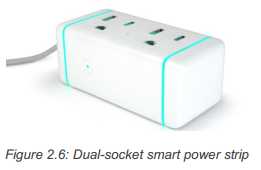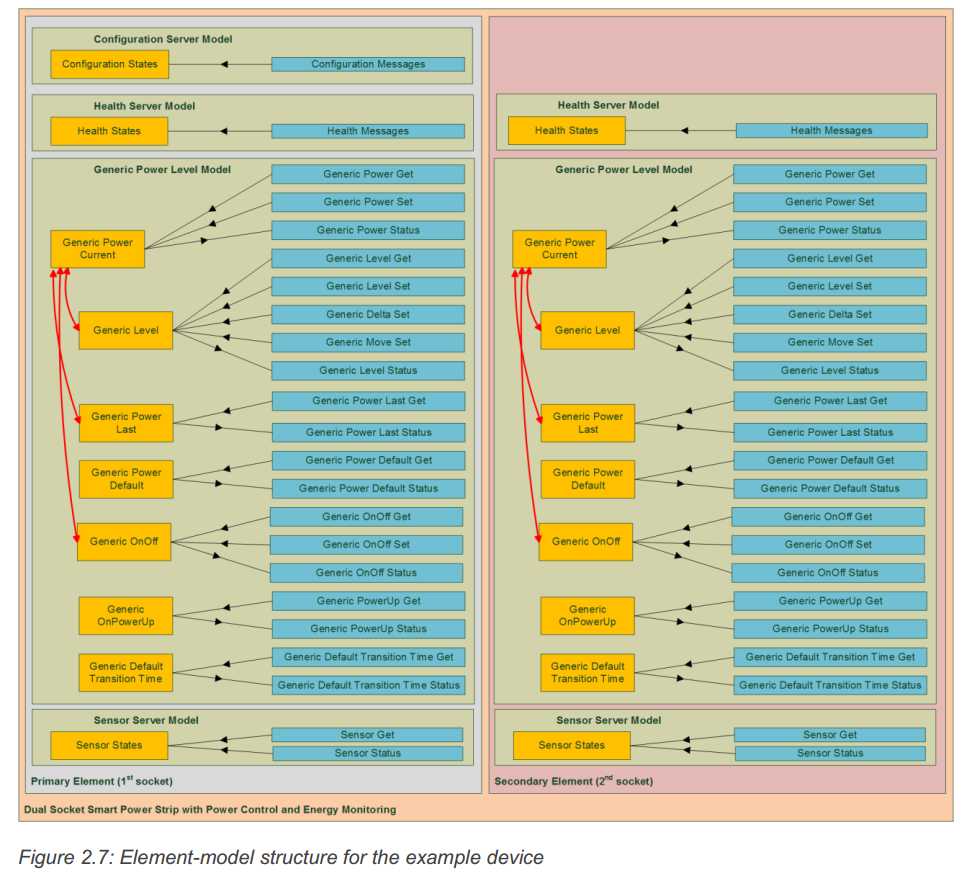标签:目标 dep define rate stat amp 地址 image 标识
To help explain how the arrangement of models within elements determines the state and behavior of a device, we will use a dual-socket smart power strip device (shown in Figure 2.6) as an example. This device has a single radio that has the low energy feature of Bluetooth and two independent power sockets, each capable of controlling the power output. This example includes states, messages, and models defined in the Mesh Model specification.
为了帮助解释元素内部模型的安排如何决定设备的状态和行为,我们将使用一个双路智能插座设备(如图2.6所示)作为示例。该设备有一个低功耗蓝牙功射频能和两个独立的电源插座,每个插座都能控制电源输出。此示例包括Mesh模型规范中定义的状态、消息和模型。

The device has two elements (see Section 2.3.4) that represent each of the two power sockets. Each element has a unicast address assigned to it.
该设备有两个元素(参见2.3.4节),分别代表两个电源插座。每个元素都有一个分配给它的单播地址。
The functionality of each element is defined by the Generic Power Level Server model. The model defines a set of states on a server, as well as a set of messages that operate on the states
每个元素的功能由通用Power Level服务器模型定义。该模型定义了服务器上的一组状态,以及对这些状态进行操作的一组消息
A Generic Power Level Set message may be sent to the device to control the output power. The message is addressed to an element and carries the element’s address in the Destination Address (DST) field (see Section 2.3.8)
可以向设备发送一个通用功率大小调节消息来控制输出功率。消息被发送到一个元素,并在目标地址(DST)字段中携带该元素的地址(参见2.3.8节)。
The sockets can also be controlled by generic devices (such as a dimmer) that implement the Generic Level Client model (and do not know anything about power control). This model simply sets a desired level to zero, a maximum value, or a value in between. Power to the sockets is controlled through state binding. In each power socket, the Generic Power Actual state is bound to the Generic Level state. A Generic Level Client sends Generic Level messages to the Generic Level Server. The Generic Level state is changed, which in turn (via the defined binding) changes the Generic Power Actual state that controls the power output.
插座还可以被通用设备(如调光器)通过Generic Level Client模型(这个模型不知道任何关于功率控制)控制。这个模型简单地设置所需的大小为零,最大价值或中间值。插座的功率是通过状态绑定来控制的。在每个电源插座中,Generic Power Actual 状态是绑定到Generic Level 状态。Generic Level 状态变化后,更改Generic Power Actual 状态去控制输出功率
Elements can report states. In our example, each socket may report power level as well as the energy consumption of a device plugged into the socket. Energy consumption is reported using messages defined by the Sensor Server model. Each message has the element’s address, which identifies the socket, in its SRC field (see Section 3.4.4.6)
元素可以报告状态。在我们的示例中,每个插座可以报告功率大小以及插入插座的设备的能耗。能耗报告使用传感器服务器模型定义的消息。每个消息的SRC字段(参见3.4.4.6节)中都有元素的地址,用于标识插座。
Figure 2.7 illustrates the element-model structure for the dual-socket device. Functionally, both elements of the device have identical features. The only difference is that the primary element handles the Configuration Server model, which is used for network management, in addition to the other models.Each element may have other models defined such as the Health Server model (see Section 4.4.4) or models defined in the Mesh Model specification [11].
图2.7演示了双插座设备的元素-模型结构。在功能上,设备的两个元素具有相同的功能。唯一的区别是,除了其他模型外,主元素还处理用于网络管理的配置服务器模型。每个元素可以定义其他模型,如Health Server模型(参见4.4.4节)或Mesh模型规范中定义的模型。

SIGMESH 2.3.7 Example device翻译
标签:目标 dep define rate stat amp 地址 image 标识
原文地址:https://www.cnblogs.com/gancai/p/12273654.html